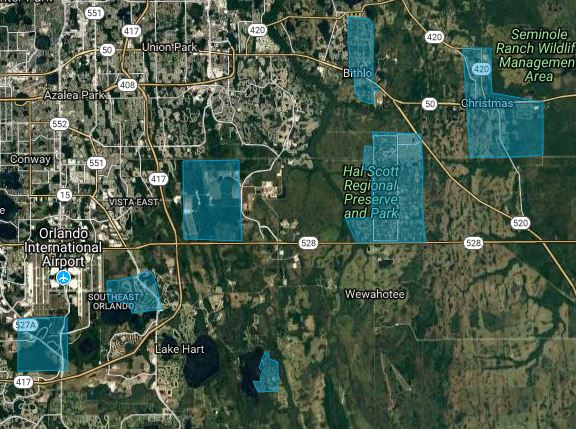Notice of Aerial Mosquito Spraying in East Orange County
Orange County, Fla. – In response to recent heavy rainfall, Orange County Mosquito Control (OCMC) will treat approximately 26,000 acres within parts of rural East Orange County by air. This will occur one day during the week of July 24, 2017 starting at approximately 9 p.m. – weather permitting.
It is not necessary to take additional precautions to safeguard livestock, pets or gardens. Officials report that aerial treatment remains the most effective way to combat high mosquito populations, as well as larva, across large acreage and areas not accessible or manageable by ground.
The decision follows as other Central Florida counties have also recently implemented aerial spraying. Orange County has not needed to utilize aerial spraying since 2011; however, warmer winter temps, along with recent heavy rain has elevated the mosquito population.
 Mosquito Control officials report that mosquito populations, particularly in East Orange County have spiked, elevating the risk of mosquito-borne illnesses that can affect both people and their pets, livestock, as well as nuisance mosquitoes. The aerial map includes the rural areas identified for aerial treatment.
Mosquito Control officials report that mosquito populations, particularly in East Orange County have spiked, elevating the risk of mosquito-borne illnesses that can affect both people and their pets, livestock, as well as nuisance mosquitoes. The aerial map includes the rural areas identified for aerial treatment.
In recent field operations, an OCMC trap captured more than 4,000 mosquitoes, in comparison to 300 the previous week. Some of these mosquito species collected can transmit West Nile Virus, Eastern Equine Encephalitis and Dog Heartworm.
While not all mosquitoes carry illness or disease, rising populations alone can be a nuisance and distract from the ability to enjoy the outdoors.
Orange County Mosquito Control personnel use several techniques to help control the various mosquito species in addition to aerial treatment, while being sensitive to the environment and other insects. All control materials used are approved by the EPA and the Florida Department of Agriculture and Consumer Services. The Centers for Disease Control has created a website specific to aerial treatment that includes frequently asked questions for residents to review if interested. These efforts strategically take place during the evening and do not include the application of materials known to be harmful to humans, animals or other insects, including bees when applied according to the label.
Efforts include:
- Source reduction. Eliminating mosquito habitats, such as discarded containers and rain gutters.
- Larval mosquito control using the appropriate methods for the habitat.
- Adult mosquito control using insecticides by ground or by air.
- Community education efforts related to preventing mosquito bites by wearing EPA-registered insect repellents and protective clothing (long-sleeved shirts and long pants).
At this time, Orange County Mosquito Control personnel ask residents to Tip, Toss and Cover!
 Tip over or toss containers like flower pots or tin cans that collect small amounts of water – many mosquitoes, particularly those that can transmit Zika virus, dengue fever and chikungunya, develop in an environment as small as a bottle cap.
Tip over or toss containers like flower pots or tin cans that collect small amounts of water – many mosquitoes, particularly those that can transmit Zika virus, dengue fever and chikungunya, develop in an environment as small as a bottle cap.- Cover skin with clothing and/or repellent that contains DEET. Cover windows and open doors with screens to prevent mosquitoes from coming inside.
- Call 311 if rising mosquito populations become nuisance or with questions.
About Orange County Government: Orange County Government strives to serve its residents and guests with integrity, honesty, fairness and professionalism. Located in Central Florida, Orange County includes 13 municipalities and is home to world-famous theme parks, one of the nation’s largest convention centers and a thriving life science research park. Seven elected members make up the Board of County Commissioners, including the Mayor, who is elected countywide. For more information, please visit www.OCFL.net or go to Orange County Government’s social media channels.
